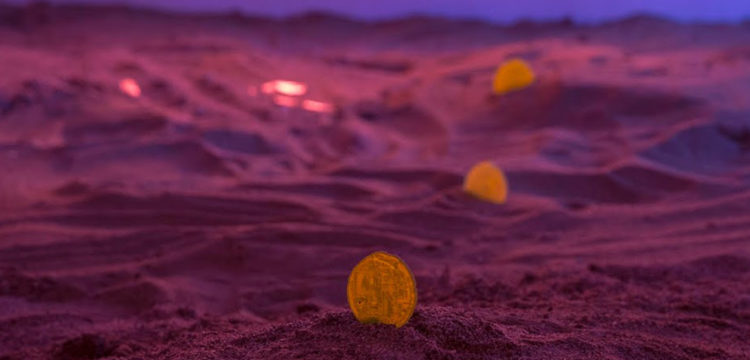The Fiction of the Neverending Fear
The Balance of the pending Catastrophe
Through a painting style made with fragile materials such as spolvero paper, chalks, charcoal and papier-mâché, Giuliana Rosso creates a composite installation that celebrates the fragility of the individual through a contemporary reinterpretation of universal themes related to art history and popular culture.
In the show, a painted and flipped over vault takes the place of the gallery floor, collapsed during the 1966 flood of the Arno. The intervention looks like the image of an ideal frescoed ceiling reflected on the surface of the water that once flooded the space. The overturning also affects the subject of the painting, which concerns a particular interpretation of the Assumption (the exhibition is entirely made of biodegradable materials and can be 100% recycled).—Text by Treti Galaxie.
I was expecting a fiction of the Catastrophe from Giuliana Rosso. It finally arrived and captured me. I have often wished—after all—to live in a world upside down: time, gravity, gazes, choices, beliefs. On the occasion of Only now, lost, they become real to me, the project of Giuliana Rosso curated by Treti Galaxie for the singular space of VEDA, a reversed perspective would be much more alike, but clearly less comfortable.
The exhibition sees four flaps of paper, precariously gathered together to form a reverse vault in the deep vertical space of the gallery. Veda’s unconventional architecture is the consequence of the 1966 flood that submerged Florence, and Rosso’s installation would suggest the reflection of a phantom frescoed vault. This is the first paradox because from the horizontality of the water Giuliana imagined the verticality of the air. In fact the vaults architecture, especially in Florence, is the common surface to depict and celebrate the transcendental powers of God.
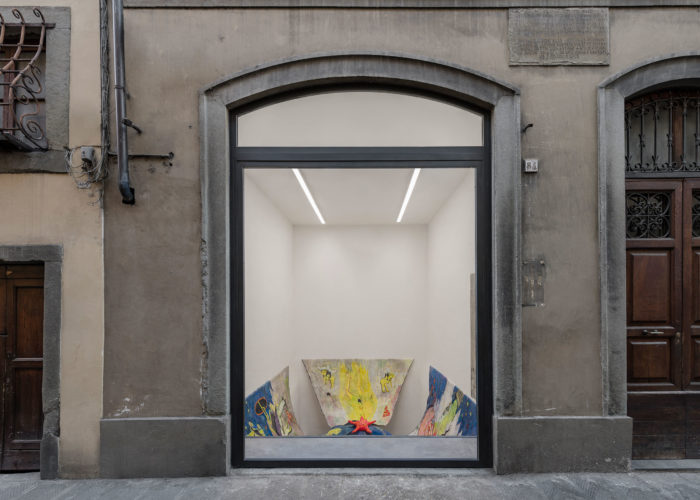
Giuliana Rosso, Only now, lost, they become real to me, 2019, Installation view. Courtesy the artist, Treti Galaxie and VEDA. Photo: Flavio Pescatori
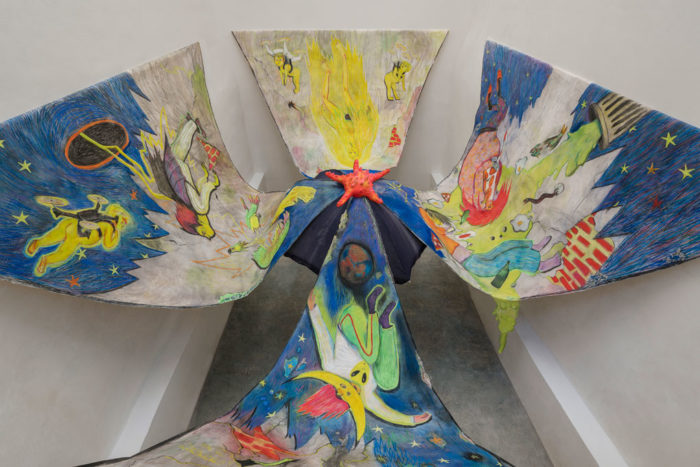
Giuliana Rosso, Only now, lost, they become real to me, 2019, Installation view. Courtesy the artist, Treti Galaxie and VEDA. Photo: Flavio Pescatori
The second paradox is connected to the subjects. Represented against a cracking background—rather than supernatural entities, they are colorful human beings whose gender isn’t well defined, much more fluid than we expect. Those portrayed caught my attention, they are the main characters of a narrative of the absurd. Drone-equipped angels hang around lazy, a moon-masked superher-him is ready to depart, the loads of hair of a radiant Eva challenge the gravity, still covering her naked body during a rigid fall. The comfort zone is never crossed by the two hunched-shoulders shy youngsters respectively holding a cat and a smartphone.
They all are falling towards the juncture of the paper vaults, but they don’t make resistance to gravity, nor try to grab a corner of the canvases. They surf the air jumping in the starfish-hole while an ecosystem of objects, the leftovers of the liquid catastrophe, whirls around them. In Rosso’s paper frescoes the figures don’t care about the consequences, they play with the catastrophe, they are not scared of it, maybe because they’re not really aware. Catastrophe after all is such a human concern, in nature it is a process of change, adjustment, renewal, rebellion.
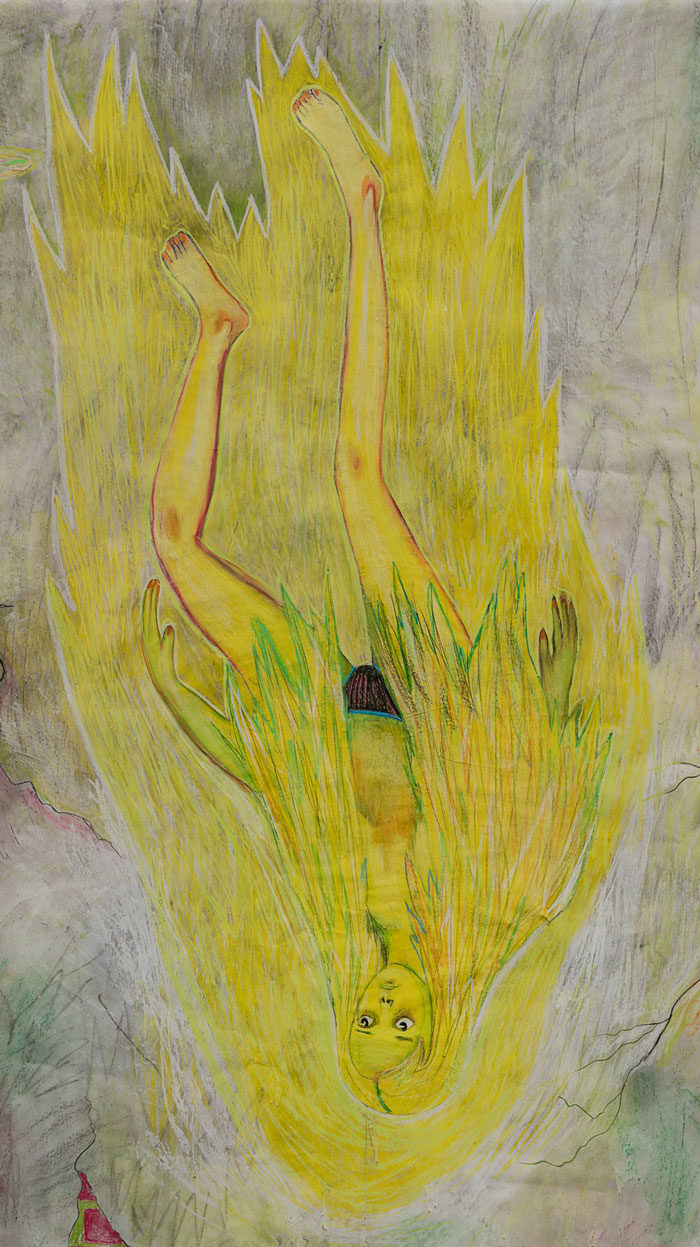
Giuliana Rosso, Only now, lost, they become real to me, 2019 (Detail). Courtesy the artist, Treti Galaxie and VEDA.
But since the definition of Anthropocene (or Capitalocene if we want to be more accurate) started to spread like wildfire we are constantly on the edge of Catastrophe. We are aware of the process that accelerate our impact on the Earth and in some ways we can imagine the possible extinction of every form of life.
Our tendency to objectify and enslave what is not Us is mirrored in the climate changes, impoverishment of soil, starvation of the species, therefore we ourselves are very fragile in what we can predict. But if we are so powerful to modify the immensity of earthly processes, why are we so scared by the consequences? Anxiety about climate change has crept into popular culture conveyed by mass and social media. It has also infused fictions and visions, as evidenced by an emerging genre called “cli-fi,” or climate-change fiction. We used to believe that those honored gods could have saved us, but I see now humans taking a step back and slowly addressing imagination, social responsibility and engagement as superpowers to be in equilibrium with the whole and not as the pendant of the Balance. But we are far from being relieved.
Look carefully, in the stomach of the melancholic parrot in the corner there isn’t plastic, but his bottle-boat is also its cage, what a dark irony.
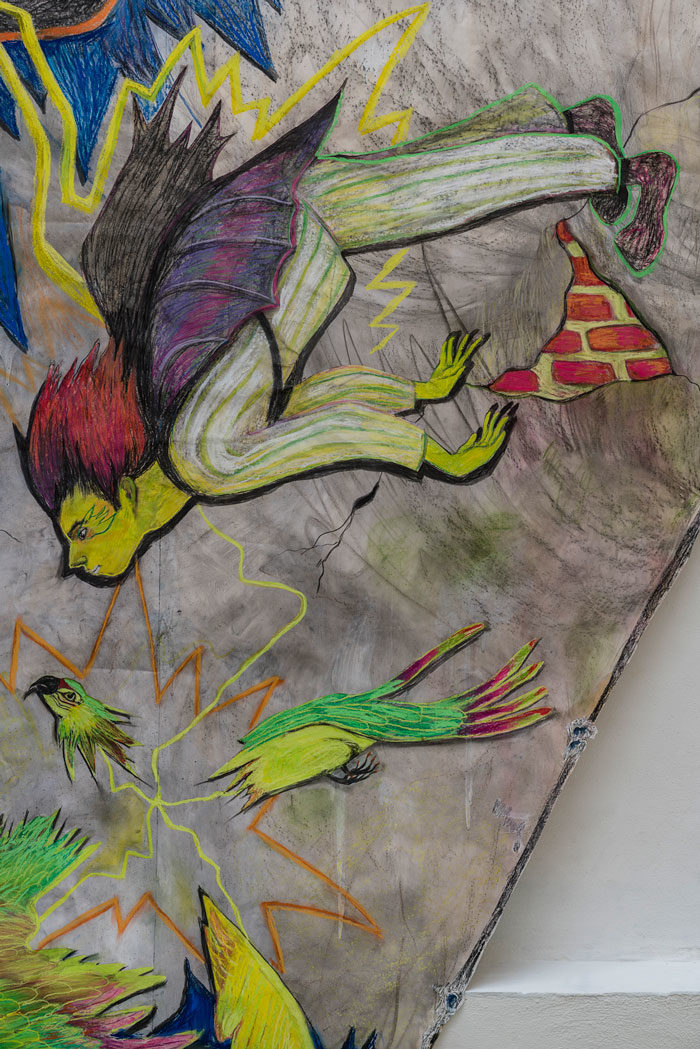
Giuliana Rosso, Only now, lost, they become real to me, 2019 (Detail). Courtesy the artist, Treti Galaxie and VEDA.
The exhibition Only now, lost, they become real to me suggests to be more than an attempt to reflect on an absence, but the very vortex in which to gaze in. It takes into account the universe of the visible, the past, the possible, the future while it depicts with vivid colors a fragile equilibrium of historical voids and preemptive images. When all resources are gone, only time matters.
This multi temporality that connects many points in time and space could be the waking factor of this sense of urgency and deep care, implied in the whole exhibition and so in these words about it.
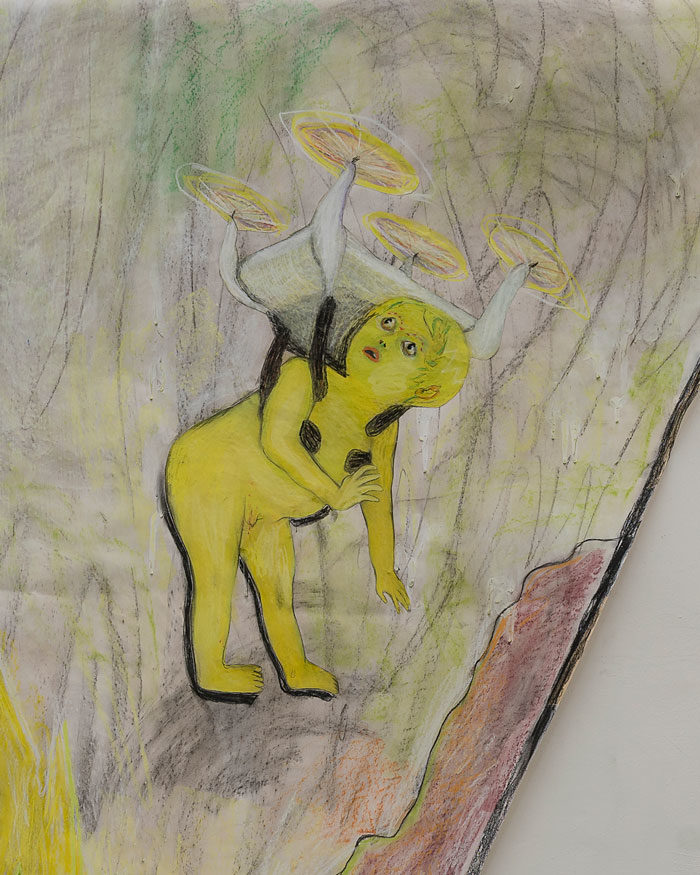
Giuliana Rosso, Only now, lost, they become real to me, 2019 (Detail). Courtesy the artist, Treti Galaxie and VEDA.
The latent ecologic discourse here connected to a well situated set of human beliefs can’t be an echo of the backward, “this is not about the catastrophe of the past!”, scream the images, but about the forthcoming. The past is lost and absent, but it’s visible everywhere. Although the loss is evoked by the title itself, Rosso’s installation is interwoven with hopeful visions in a world rooted in apocalypse.
We haven’t missed all the chances to make the best hypothesis real, but we need to face the never-ending fear of the end. The future sketched here is the surfacing of the might be coming from a hushed and oppressed world. The claim for a space for the lost ones, for the clumsy, the birds, the falling stars and for those who barely manage to stay afloat.





